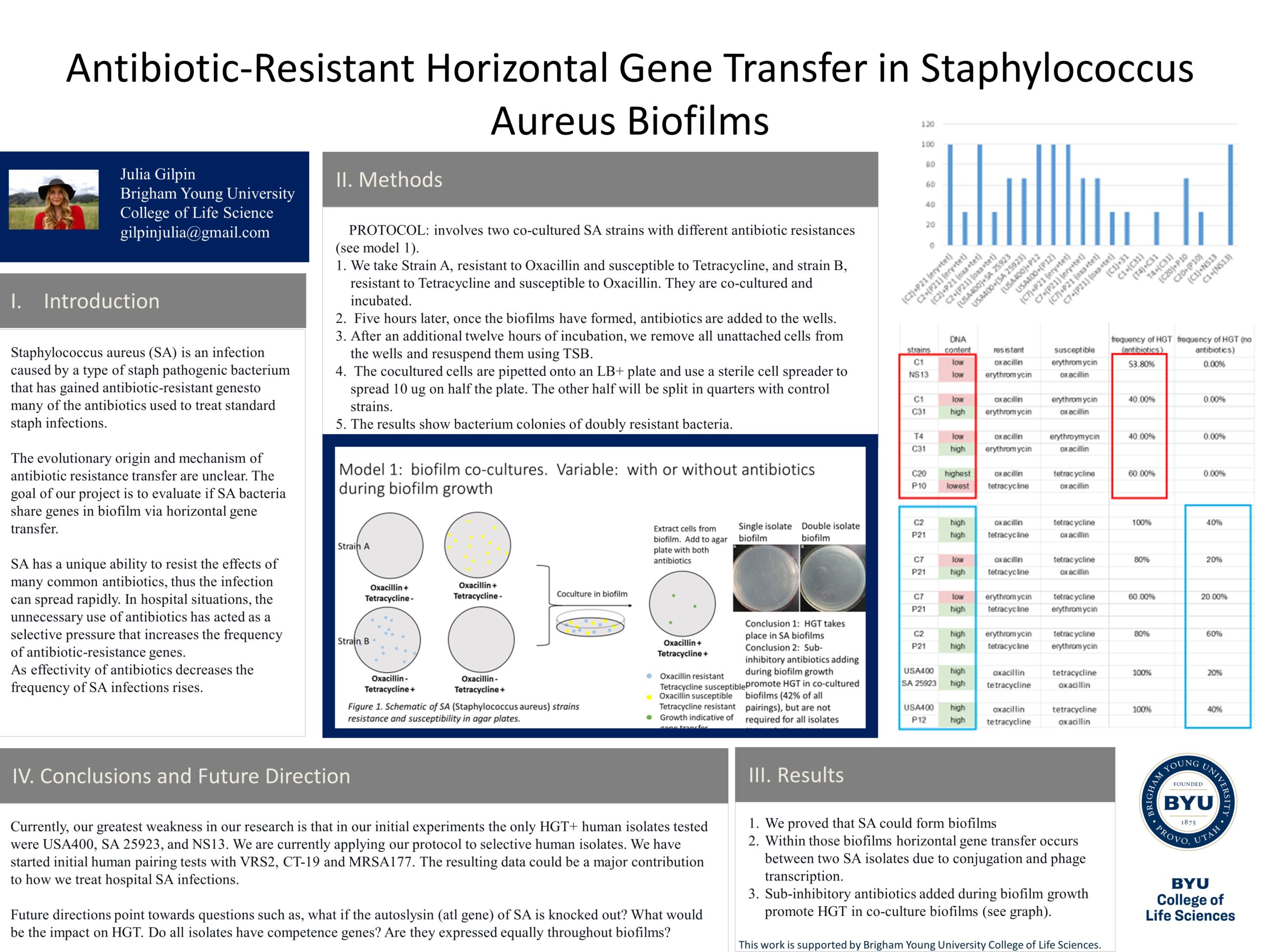Presenter Name: Julia Gilpin
Description
Currently, our lab has collected data suggesting that Staphylococcus aureus (SA) grows in biofilms. It is known that SA contains a significant number of antibiotic-resistant genes, especially MRSA. Previous research has shown that other kinds of bacteria are known to share genes in a biofilm, currently, SA is not recognized to do so. Biofilms usually consist of mixtures of bacteria, which protect the bacteria from harmful environments and antibiotics. Past studies have shown that biofilms are a prime location for horizontal gene transfer due to the high concentrations of eDNA there is movement of genetic information between organisms. This process includes the sharing of antibiotic-resistance genes among bacteria.
Our project's goal is to understand how SA gains antibiotic resistance, specifically through horizontal gene transfer (HGT). Livestock raw meat contains extremely high levels of SA, and the isolates have high antibiotic resistance. Our lab was able to create protocols that demonstrate that HGT is a mechanism that SA uses to transfer genes in biofilms. This protocol involves co-culturing two SA strains with different antibiotic resistances. For example, imagine strain A, resistant to Oxacillin and susceptible to Tetracycline, and strain B, resistant to Tetracycline and susceptible to Oxacillin are co-cultured and incubated. Five hours later once the biofilms have formed, we add in the antibiotics. After an additional twelve hours of incubation, we remove all unattached cells from the wells and resuspend them using TSB. We then pipette the cocultured cells onto an LB+ plate and use a sterile cell spreader to spread 10 ug on half the plate. The other half will be split in quarters with our control strains. If our hypothesis was correct, we should expect to find bacteria colonies of doubly resistant bacteria. Using this procedure our lab was able to collect data that supports our initial hypothesis that HGT takes place in SA biofilms and that those sub-inhibitory antibiotics added during biofilm growth promote HGT in co-culture biofilms.
Berges's lab has previously shown that raw meat products from livestock treated with antibiotics have
significantly higher AR levels in SA isolates from raw meat products. Livestock SA strains do not directly cause disease in humans, but they may transfer AR genes to human SA isolates. Our current research involves applying this procedure to human isolate SA bacteria. Human isolate SA infections are a significant world threat to patients within the healthcare system. The objective of our research is to help clarify the mechanism SA uses to gain antibiotic resistance genes in nature. This could help us better understand how to treat and prevent life-threatening infections from occurring. Continually, if we can determine how SA microorganisms are gaining AR genes, we can formulate better and effective treatment protocols.
significantly higher AR levels in SA isolates from raw meat products. Livestock SA strains do not directly cause disease in humans, but they may transfer AR genes to human SA isolates. Our current research involves applying this procedure to human isolate SA bacteria. Human isolate SA infections are a significant world threat to patients within the healthcare system. The objective of our research is to help clarify the mechanism SA uses to gain antibiotic resistance genes in nature. This could help us better understand how to treat and prevent life-threatening infections from occurring. Continually, if we can determine how SA microorganisms are gaining AR genes, we can formulate better and effective treatment protocols.
University / Institution: Brigham Young University
Type: Poster
Format: Virtual
Area of Research: Health & Medicine
Email: gilpinjulia@gmail.com
Faculty Mentor: Brad Berges

